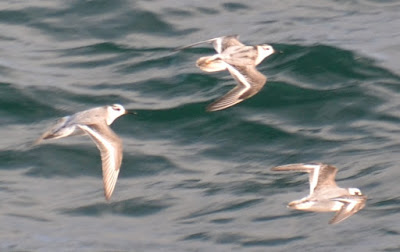 |
| non-breeding |
Smaller wader
Straight bill
Short legs
Lobed toes
Adults:
Distinct white stripe down the wing
Dark stripe down the tail
Contrasting color on sides of rump
Breeding plumage:
Rufous neck and underparts
Dark brown and black above
White cheek patches
Yellow bill
Black cap (female) / Brown cap (male)
Non-breeding plumage: (photographed)
Black backs edged in buff
Buff underparts and head
Dark patch through the eye
Rufous neck and underparts
Dark brown and black above
White cheek patches
Yellow bill
Black cap (female) / Brown cap (male)
Non-breeding plumage: (photographed)
Light grey above, unstreaked
White below
White head
White head
Black ear patch behind the eye
Black bill with lighter base
Juveniles:Black backs edged in buff
Buff underparts and head
Dark patch through the eye
Listen to its call.
Although phalaropes are sandpipers, which are typically shorebirds, these birds spend most of the year out at sea. They are also one of the few birds where the female of the species is more colourful and larger than the male. This is because the females are polyandrous. They have to look good to attracted the attention of multiple males. In contrast, the males need to be duller to avoid detection of predators while providing most of the parental care.
Learn more about the Red Phalarope.
No comments:
Post a Comment